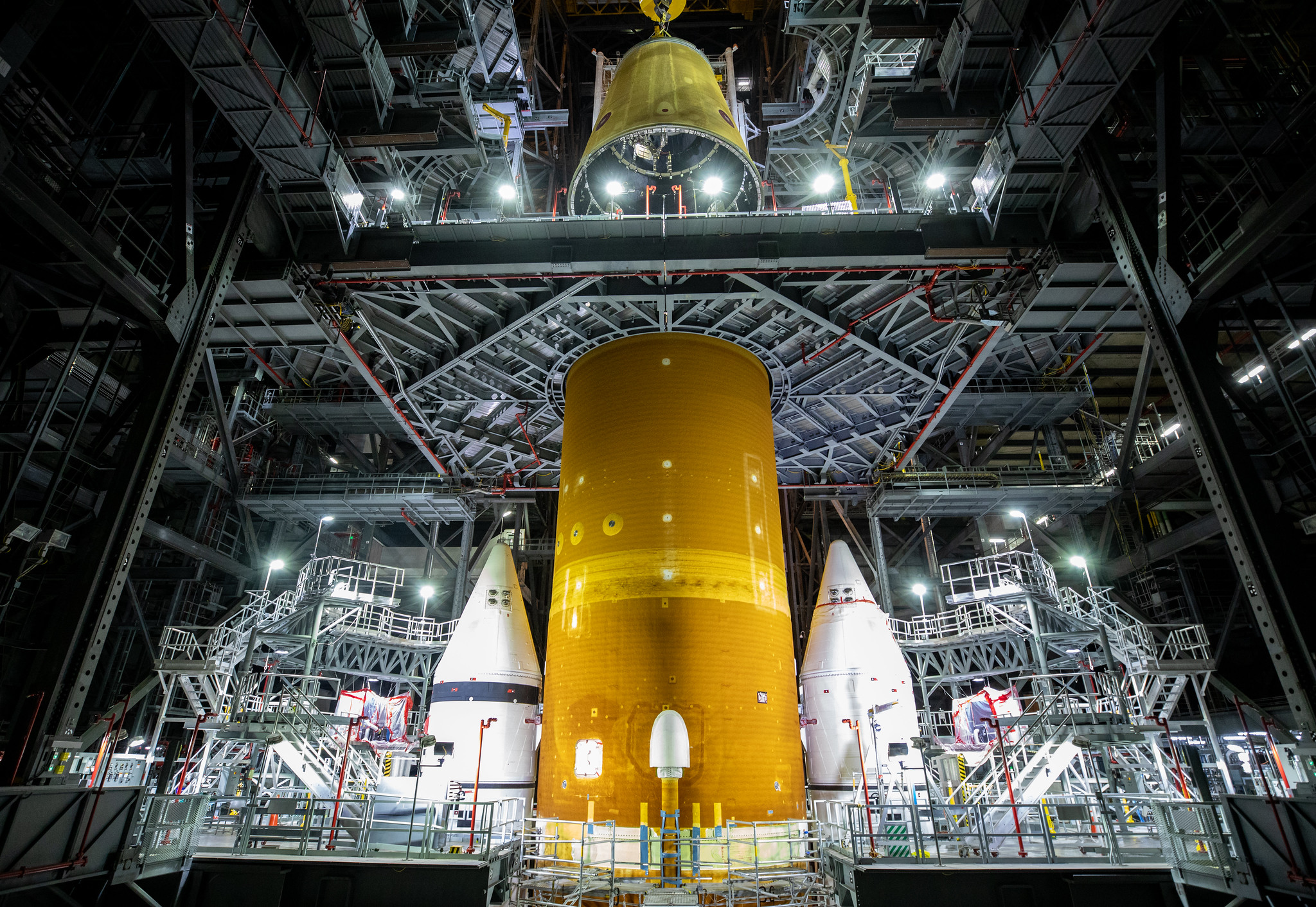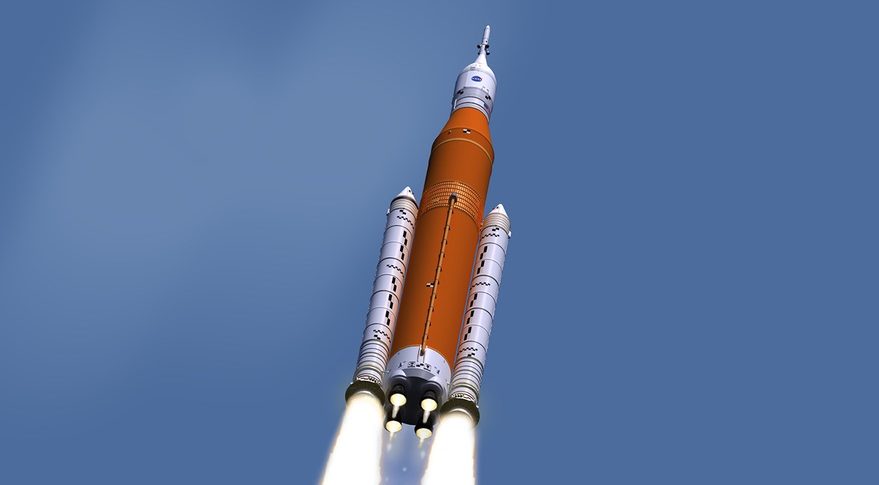
In-Depth View Of The Rocket Taking Humans Back To The Moon
One of humanity’s greatest achievements was putting the first humans on the Moon. This happened over 50 years ago on the most powerful rocket ever built, the Saturn V. Since then, NASA has worked on different launch vehicles and projects but nothing came close to the power and size of the Saturn V. This is all changing with the development and testing of NASA’s SLS or Space Launch System.
The Space Launch System is planned to be one of the most powerful rockets in the world. SLS will help bring humans back to the Moon and beyond using multiple boosters, RS-25 Engines, the Exploration Upper Stage, and multiple variants. All combine into a single launch vehicle with the capabilities to bring humans back to the Moon and even further into deep space.
While the Space Launch System is set to become an incredible launch vehicle, it has not developed without some problems. A large combination of delays and other complications has slowed the project and increased the price significantly. This will end up having a large effect on future missions to the Moon and beyond.
What Is The Space Launch System’s Purpose?

NASA is working to return humans to the Moon with the Artemis mission. The agency not only wants humans to return but set up a more permanent presence and base on the surface. The Space Launch System is a key component to practically every NASA-related mission to the Moon in the future. This is because SLS is set up to be a long-term launch vehicle for NASA. More specifically, the purpose of this launch vehicle is to bring humans and cargo to the Moon. However, the SLS will not be responsible for putting humans on the surface of the Moon.
The Space Launch System will transport humans to a Moon space station named Gateway. From here, a pre-set lunar lander from companies such as SpaceX will be set up to then descend to the surface. When the mission is complete, the lunar lander will bring humans back to the space station. From here they will board the final remaining part of SLS, Orion, and head back to Earth. The Space Launch system is one of the biggest rockets ever created. It is also meant to be one of the most powerful as well. However, it’s important to point out that the launch vehicle is not planned to be reusable. Additionally, SLS is expected to have an immense cost per launch which will slow down and limit future missions.
Space Launch System Features
Boosters – The first feature of SLS that I want to point out is the boosters. The Space Launch system consists of a large core stage with two additional boosters on either side. These solid rocket boosters will power the initial flights of SLS and are derived from the Shuttle. To increase the power of the boosters, Northrup Grumman, the original contractor of the booster, made some necessary upgrades. Some of these upgrades include new avionics, case insulation, propellant design, and removal of recovery parachutes. Each solid rocket booster stands at 177 feet tall, 12 feet wide, and weighs 1.6 million pounds. Additionally, each booster produces around 3.6 million pounds of thrust and operates for 126 seconds. This thrust is necessary to launch the extremely heavy Space Launch System out of the atmosphere. The two boosters alone provide more than 75 percent of the thrust at liftoff.
RS-25 Engines – The next important feature of SLS are the engines. Taking a look at the core stage, propulsion will be provided by four RS-25 engines. Similar to the solid rocket boosters, NASA is working to upgrade a previously used component. Some of the upgrades they made to the RS-25 engine include a new engine controller, nozzle insulation, and required operation at 512,000 lbs of thrust. These four engines alone will provide around 2 million pounds of thrust during the flight. The RS-25 engines are designed and built by Aerojet Rocketdyne. These same engines helped power the shuttle for over three decades and 135 missions. NASA already has an inventory of 16 RS-25 engines from the shuttle program that will be used to support the first four SLS missions. Each engine stands at 14 feet by 8 feet and weighs almost 8 thousand pounds. Each engine produces 512,000 pounds of thrust with an operational thrust of 109%. These combined with the two solid rocket boosters will propel the Space Launch System out of Earth’s atmosphere.
Exploration Upper Stage – Another important aspect of the Space Launch System is the Exploration Upper Stage. This stage of the launch vehicle is powered by four RL10 engines. There are many different variants of SLS, each has slight changes in different areas of the launch vehicle. The Exploration Upper Stage will be used for the SLS Block 1B Crew Variant replacing the ICPS. The main difference between these two stages is the engines. The Exploration Upper Stage will have four RL10 engines and produce almost four times the thrust as the ICPS variant. Specifically, the 97,000 pounds of thrust produced will allow more than 38 tons for the crew variant to be sent to the Moon.
Multiple Variants – The final feature of SLS that is very important are the different variants. The Space Launch System has many different variants but there are six I want to point out. Each variant has a few changes in specific areas that facilitate different mission goals and objectives. Within the six variants, there are three main sections. This includes Block 1, Block 1B, and Block 2. Each of these three Block variants has a crew and cargo variant as well. Starting with Block 1 there is the SLS Block 1 Crew and the SLS Block 1 Cargo. These two are the least powerful out of all the variants producing around 8.8 million pounds of thrust. The next two variants are the crew and cargo versions of the SLS Block 1B. These are larger and more powerful producing 8.9 million pounds of thrust. Finally, there is the crew and cargo variant of the SLS Block 2. These are the most powerful by far producing 9.5 million pounds of thrust. This allows more crew and cargo to be transported to the Moon and beyond in a single mission.
Delays & Complications

While the Space Launch System is set up to become one of the most powerful launch vehicles in the world, it is by no means perfect. There are a lot of different delays and complications that are worth bringing up. The first aspect I want to focus on is the technology used. You may have noticed a common theme but a lot of the key components and technology of SLS are just refurbished parts from past rockets such as the shuttle. This is not necessarily a bad thing but it could add to the cost and hurt the efficiency of the rocket. Another issue is the launch vehicle’s expected cost per launch. The Space Launch System’s cost per launch is estimated at around 2 billion per launch, with some estimates going as high as 4 billion. This is an immense amount of money even for NASA and would hurt the program significantly. A base on the Moon requires consistent and frequent launches which will not be easy with such a high price tag. Finally, there are the delays. The Artemis mission overall along with SLS specifically has had a lot of delays. This has pushed the expected initial launch date back farther and farther.
Conclusion
Heading back to the Moon is an incredible and extremely difficult goal. NASA plans to overcome a lot of these challenges by creating one of the biggest and most powerful rockets in the world. The agency ended up creating the Space Launch System. This rocket is meant to bring humans back to the surface using multiple solid rocket boosters, RS-25 engines, Exploration Upper Stage, and multiple variants. Each helping to launch and deliver tons of cargo and crew. We will have to wait and see how development continues and if NASA can finish the launch vehicle on time.
